Eindhoven
| Eindhoven | |||
|---|---|---|---|
| — Municipality/City — | |||
 |
|||
|
|||
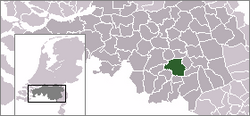 |
|||
| Coordinates: | |||
| Country | Netherlands | ||
| Province | North Brabant | ||
| Government | |||
| - Mayor | R. van Gijzel (PvdA) | ||
| Area(2006) | |||
| - Municipality/City | 88.84 km2 (34.3 sq mi) | ||
| - Land | 87.75 km2 (33.9 sq mi) | ||
| - Water | 1.09 km2 (0.4 sq mi) | ||
| Population (01 January 2010) | |||
| - Municipality/City | 213,809 | ||
| - Density | 2,407/km2 (6,234.1/sq mi) | ||
| - Urban | 440,353 | ||
| - Metro | 775,345 | ||
| Source: CBS, Statline. | |||
| Time zone | CET (UTC+1) | ||
| - Summer (DST) | CEST (UTC+2) | ||
| Website | http://www.eindhoven.eu/ | ||
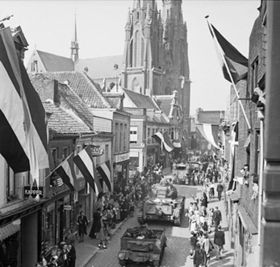
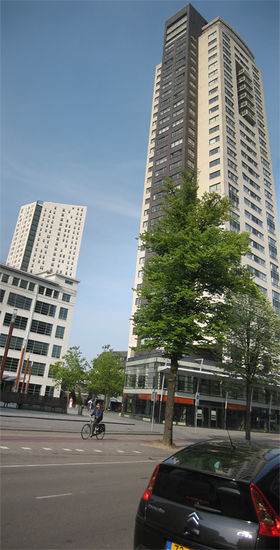
Eindhoven (Dutch pronunciation: [ˈɛinthoːvə(n)] (![]() listen)) is a municipality and a city located in the province of Noord-Brabant in the south of the Netherlands, originally at the confluence of the Dommel and Gender streams. The Gender was dammed off short of the city centre in the 1950s, but the Dommel still runs through the city.
listen)) is a municipality and a city located in the province of Noord-Brabant in the south of the Netherlands, originally at the confluence of the Dommel and Gender streams. The Gender was dammed off short of the city centre in the 1950s, but the Dommel still runs through the city.
Neighbouring cities and towns include Son en Breugel, Nuenen, Geldrop-Mierlo, Heeze-Leende, Waalre, Veldhoven, Eersel, Oirschot and Best. The agglomeration has some 440,000 inhabitants. The metropolitan area (which includes Helmond) has nearly 750,000 inhabitants. Also, Eindhoven is part of Brabant Stad, a combined metropolitan area with more than 2 million inhabitants.
Contents |
History
The written history of Eindhoven started in 1232, when Duke Hendrik I of Brabant granted city rights to Endehoven, then a small town right on the confluence of the Dommel and Gender streams. The city's name translates literally as "End Yards", reflecting its position at the southern end of Woensel. At the time of granting of its charter, Eindhoven had approximately 170 houses enclosed by a rampart. Just outside of the city walls stood a small castle. The city was also granted the right to organize a weekly market and the farmers in nearby villages were obliged to come to Eindhoven to sell their produce. Another factor in its establishment was its location on the trade route from Holland to Liège.
Around 1388 the city's fortifications were strengthened further. And between 1413 and 1420, a new castle was built within the city walls. In 1486, Eindhoven was plundered and burned by troops from Gelderland. The reconstruction was finished in 1502, with a stronger rampart and a new castle. However, in 1543 Eindhoven fell again: its defense works were neglected due to poverty.
A big fire in 1554 destroyed 75% of the houses but by 1560 these had been rebuilt with the help of William I of Orange. During the Dutch Revolt, Eindhoven changed hands between the Dutch and the Spanish several times during which it was burned down by renegade Spanish soldiers, until finally in 1583 it was captured once more by Spanish troops and its city walls were demolished. Eindhoven did not become part of the Netherlands until 1629. During the French occupation Eindhoven suffered again with many of its houses destroyed by the invading forces. Eindhoven remained a minor city after that until the start of the industrial revolution.
The industrial revolution of the Nineteenth century provided a major growth impulse. Canals, roads and railroads were constructed. Eindhoven was connected to the major Zuid-Willemsvaart canal through the Eindhovens Kanaal branch in 1843 and was connected by rail to Tilburg, 's-Hertogenbosch, Venlo and Belgium between 1866 and 1870. Industrial activities initially centred around tobacco and textile and boomed with the rise of lighting and electronics giant Philips, which was founded as a light bulb manufacturing company in Eindhoven in 1891.
Industrialization brought population growth to Eindhoven. At the establishment of the Kingdom of the Netherlands in 1815, Eindhoven had 2.310 inhabitants. By 1920 it was 47.946; by 1925 it was 63.870 and in 1935 that had ballooned to 103.030[1]. The explosive growth of industry in the region and the subsequent housing needs of workers called for radical changes in administration, as the City of Eindhoven was still confined to its medieval moat city limits. In 1920, the five neighbouring municipalities of Woensel (to the north), Tongelre (northeast and east), Stratum (southeast), Gestel en Blaarthem (southwest) and Strijp (west), which already bore the brunt of the housing needs and related problems, were incorporated into the new Groot-Eindhoven ("Greater Eindhoven") municipality. The prefix "Groot-" was later dropped.
After the incorporation of 1920, the five former municipalities became districts of the Municipality of Eindhoven, with Eindhoven-Centrum (the City proper) forming the sixth. Since then, an additional seventh district has been formed by dividing the largest district, that of Woensel, into Woensel-Zuid and Woensel-Noord.
The early twentieth century saw additions in technical industry with the advent of car and truck manufacturing company Van Doorne's Automobiel Fabriek (DAF) and the subsequent shift towards electronics and engineering, with the traditional tobacco and textile industries waning and finally disappearing in the Seventies.
Large-scale air raids in World War II, including the preliminary bombing during Operation Market Garden to aid the US 101st Airborne Division paratroopers in securing the bridges in and around the town on 18 September 1944, destroyed large parts of the city. The reconstruction that followed left very little historical remains and the post-war reconstruction period saw drastic renovation plans in highrise style, some of which were implemented. At the time, there was little regard for historical heritage; in the 1960s, a new city hall was built and its neo-gothic predecessor (1867) demolished to make way for a planned arterial road that never materialised.
The 1970s, 1980s and 1990s saw large-scale housing developments in the districts of Woensel-Zuid and Woensel-Noord, making Eindhoven the fifth-largest city in the Netherlands. At the turn of the century, a whole new housing development called Meerhoven was constructed at the site of the old airport of Welschap, west of Eindhoven. The airport itself, now called Eindhoven Airport, had moved earlier to a new location, paving the way for much needed new houses. Meerhoven is part of the Strijp district and partially lies on lands annexed from the municipality of Veldhoven.
In the 2000s decade, Eindhoven emerged as the capital of Dutch industrial design. The Design Academy Eindhoven has produced major Dutch designers, such as Maarten Baas, Marcel Wanders, Richard Hutten, Jurgen Bey, and Hella Jongerius. The school also has a strong affiliation with droog design. In 2003, Time Magazine called the Academy, "The School of Cool." Due to the fame of the D.A.E, Eindhoven has been able to grow in the design industry with such events as the Dutch Design Week, that takes place every October. While most of Philips' industries have moved out, the Philips Design Bureau is still in Eindhoven.
Geography
Terrain map of the Eindhoven Region
The villages and city that make up modern Eindhoven were originally built on sandy elevations between the Dommel, Gender and Tongelreep streams. Beginning in the nineteenth Century, the basins of the streams themselves have also been used as housing grounds, resulting in occasional floodings in the city centre. Partly to reduce flooding, the bed of the Gender stream, which flowed directly through the city centre, was dammed off and filled up after the War, and the course of the Dommel was regulated. New ecologial and socio-historical insights have led to parts of the Dommel's course being restored to their original states, and plans to have the Gender flow through the centre once again (link to article in Dutch).
The large-scale housing developments of the Twentieth Century saw residential areas being built on former agricultural lands and woods, former heaths that had been turned into cultivable lands in the Nineteenth Century.
The city is currently divided into seven districts:
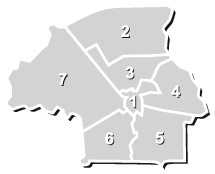 |
|
Demographics
Population
City size and ethnic makeup
As of 2010[update], the population of Eindhoven consisted of 213,809 persons (according to the Eindhoven city council, the city will reach the maximum population of 230,000 inhabitants around the year 2025). Of these, 28.8% or some 61,546 people are of foreign descent.[2] People are classified as being of foreign descent when they were born outside of the Netherlands, or when at least one of their parents was born outside of the Netherlands.
Large minority groups include:[2]
- Turks (9,993) (4.7%)
- Moroccans (5,486) (2.6%)
- Surinamese (3,664) (1.7%)
- Antilleans/Arubans (2,513) (1.2%)
Other large minority groups are Germans and Indonesians.
The municipal agglomeration of Eindhoven (an administrative construct which includes only some of the surrounding towns and villages) has 327,245 inhabitants as of January 1, 2010.
District sizes
Of all Eindhoven districts, the historical centre is by far the smallest in size and population, numbering only 5,419 in 2006. Woensel-Noord is the largest, having been the city's main area of expansion for several decades.
Population figures for all districts, as of January 1, 2008, ranked by size:[3]
- Woensel-Noord (65,429)
- Woensel-Zuid (35,789)
- Stratum (31,778)
- Gestel (26,590)
- Strijp (25,402)
- Tongelre (19,680)
- Centrum (5,757)
Religion
Eindhoven is located in the Southeast of the province Noord-Brabant. This area is historically Roman-Catholic and the population of Eindhoven was similarly mostly Roman-Catholic for a very long time. However, the internationalizing influence of the university, Philips and other companies have created a more mixed population over the last few decades.
The Eindhoven agglomeration has the following religious makeup as of 2003 [4]:
- Roman-Catholic: 65,4%
- Reformed: 1,1%
- Dutch Reformed: 2,9%
- Muslim: 4,2%
- Atheist: 25,1%
The spiritual needs of the Eindhoven population are tended by a large number of churches (united in the Eindhoven Raad van Kerken), two mosques and one synagogue. In addition, Eindhoven is also the abode of street preacher Arnol Kox.
Crime
In research by the Dutch newspaper Algemeen Dagblad based on the police's statistical data on crime rates, Eindhoven was found to have the highest crime rate in the Netherlands for 2006, 2007 and 2009.
In 2009, in the Eindhoven agglomeration, the following numbers of crimes were recorded[5]:
| Category | Number |
|---|---|
| Total | 61.539 |
| Monetary (including burglary, theft) | 37.266 |
| Destruction and public disorder | 9.861 |
| Violent crime | 5.568 |
| Other crimes (criminal code) | 562 |
| Traffic crimes | 6.665 |
| Drug related | 1.094 |
| (Fire)arms related | 343 |
| Environmental | 19 |
| Other crimes (other laws) | 161 |
Economy
Eindhoven has grown from a little village in 1232 to one of the bigger cities in the Netherlands with around 212,000 inhabitants in 2009. Much of its growth is due to Philips and DAF Trucks.
After the resurrection of The Netherlands in 1815 and the end of the Belgian Revolution, Eindhoven was a small village of some 1250 people in an economically backward and mostly agricultural area. Cheap land, cheap labor and the existence of pre-industrial homesourcing (huisnijverheid in Dutch) made Eindhoven an attractive area for the developing industries which were being stimulated by the government of King William I. During the 19th century, Eindhoven grew into an industrial town with factories for textile weaving, cigar manufacturing, match making and hat making. Most of these industries disappeared again after World War II, though.
In 1891, brothers Gerard and Anton Philips founded the small light bulb factory that would grow into one of the largest electronics firms in the world. Philips' presence is probably the largest single contributing factor to the major growth of Eindhoven in the 20th century. It attracted and spun off many hi-tech companies, making Eindhoven a major technology and industrial hub. In 2005, a full third of the total amount of money spent on research in the Netherlands was spent in or around Eindhoven. A quarter of the jobs in the region are in technology and ICT, with companies such as FEI Company (once Philips Electron Optics), NXP Semiconductors (formerly Philips Semiconductors), ASML, Toolex, Simac, Neways, Atos Origin and the aforementioned Philips and DAF.
Eindhoven has long been a centre of cooperation between research institutes and industry. This tradition started with Philips (the NatLab was a physical expression of this) and has since expanded to large cooperative networks. The university hosts an incubator for technology startups (called the Twinning Center) and the NatLab has developed into the High Tech Campus Eindhoven. Also, TNO has opened a branch on the university campus.
This cooperative tradition has also developed into a different direction than the traditional technology research done at the university. Starting in 2002, the university, the Catharina hospital, Philips Medical and the University of Maastricht joined forces and started joint research into biomedical science, technology and engineering. Within Eindhoven, this research has been concentrated in a new university faculty (BioMedical Technology or BMT). This development has also made Eindhoven a biomedical technology hub within the country and its (European) region.
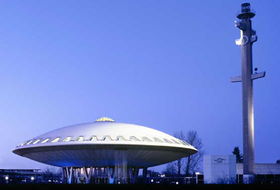
Prime examples of industrial heritage in Eindhoven are the renovated Witte Dame ("White Lady") complex, a former Philips lamp factory; and the Admirant building (informally known as Bruine Heer or "Brown Gentleman" in reference to the Witte Dame across the street), the former Philips main offices. The Witte Dame currently houses the municipal library, the Design Academy and a selection of shops. The Admirant has been renovated into an office building for small companies. Across the street from the Witte Dame and next to the Admirant is Philips' first light bulb factory (nicknamed Roze Baby, or "Pink Baby", in reference to its pink colour and much smaller size when compared to the "White Lady" and "Brown Gentleman"). The small building now houses the[6] "Centrum Kunstlicht in de Kunst" (centre artificial light in art) and the[7] "Philips Incandescent Lamp Factory of 1891" museum.
Knowledge economy initiatives
Due to its high-tech environment, Eindhoven is part of several initiatives to develop, foster and increase a knowledge economy. Chief among these are:
- Brainport Top Technology Region[8]: A cooperative initiave of local government, industry and the Eindhoven University of Technology to develop the local knowledge economy of the Eindhoven region.
- Brainport Development[9]: An extension of the Top Technology Region, Brainport Development serves commercial exploitation and advertising of the region.
- SRE[10]: The Samenwerkingsverband Regio Eindhoven is a cooperative agreement among the municipalities in the Eindhoven metropolitan area. Although SRE is far more than just an economic agreement, it includes economic cooperation.
- The Eindhoven-Leuven-Aachen triangle[11]: An extensive cooperation agreement between the universities and surrounding regions of Eindhoven, Leuven (Belgium) and Aachen (Germany).
- Within the Eindhoven region (particularly around Helmond) several parties are working together to set up an automotive testing facility of European scale, for testing and European certification of vehicles. This cooperation involves the Eindhoven University of Technology, TNO Automotive and the different automotive companies in and around Helmond.
Knowledge and Innovation Community EIT
Eindhoven is one of co-location centres of Knowledge and Innovation Community (Sustainable Energy) of The European Institute of Innovation and Technology (EIT)[12]
Co-location centres – KIC Inno Energy:
CC Germany: Karlsruhe, CC Alps Valleys: Grenoble, CC Benelux: Eindhoven / Leuven, CC Iberia: Barcelona, CC PolandPlus: Krakow, CC Sweden: Stockholm
InnoEnergy is a strongly integrated alliance of reputable players from the education, research and industry sectors. It was created based on long standing links of cooperation as well as the principles of excellence and transformation. The partners have jointly developed a strategy to tackle the weaknesses of the European innovation landscape and aim to be the leading motor for innovation in the field of sustainable energy.The KIC will create economical and societal value by developing ideas from mind to market.[13]
Education
Eindhoven, being a city with a 200,000+ population, is served by a large number of schools both at primary and secondary education levels. In addition, Eindhoven is a higher-education hub within the southern Netherlands, with several institutes of higher education that serve students from the extended region of Noord-Brabant, Zeeland, Limburg and parts of the surrounding provinces.
Primary education
Primary education is provided to the children aged 4 to 12 in Eindhoven through a large number of primary schools:
| Area | Gestel | Stratum | Strijp | Tongelre | Woensel |
|---|---|---|---|---|---|
| Schools |
|
|
|
|
|
- Special needs primary education:
- SALTO school Jan Nieuwenhuizen
- SKPO school De Reis van Brandaan
- SKPO school Petraschool
- SALTO school De Vijfkamp
Secondary education
Secondar education is provided to the children aged 12 to 18 in Eindhoven through several highschools:
| Area | Gestel | Stratum | Strijp | Tongelre | Woensel |
|---|---|---|---|---|---|
| Schools |
|
|
|
|
|
Special needs secondary education:
- Sondervickcollege, Locatie de Stolberg
- De Korenaer
- Mgr. Bekkers
- De Beemden
- Mytylschool
- Pleincollege Antoon Schellens
- Praktijkschool Eindhoven
- VSO Ekkersbeek
- Instituut 'St. Marie'
Higher and adult education
Eindhoven hosts four different public institutions for higher and adult education, as well as a number of private institutions offering courses and trainings. The public institutions hosted in Eindhoven are:
- The Eindhoven University of Technology.
- The Fontys University of Applied Sciences (Eindhoven branch).
- The Design Academy.
- The Regionaal Opleidingen Centrum Eindhoven (ROC Eindhoven).
The Open University also has a study center in Eindhoven.
Government and politics
City Council
The city council is the legislative council at the municipal level in Eindhoven; its existence is mandated by the Constitution of the Netherlands. The Eindhoven city council consists of 45 elected representatives from the Eindhoven municipality. These are elected during municipal elections from candidates running in Eindhoven. Eindhoven politics consists of local branches of the national political parties and purely local parties with strictly local interests. The city council reflects this mix in its makeup.
The last two municipal elections were held on March 7, 2006 and on March 3, 2010. The division of the 45 seats in the Eindhoven city council after these elections is shown below[14]:
| Party | Percentage in 2006 | Seats in 2006 | Percentage in 2010 | Seats in 2010 | Election results (percentages) 2010 |
|---|---|---|---|---|---|
| PvdA | 26,99% | 14 | 20,56% | 10 | 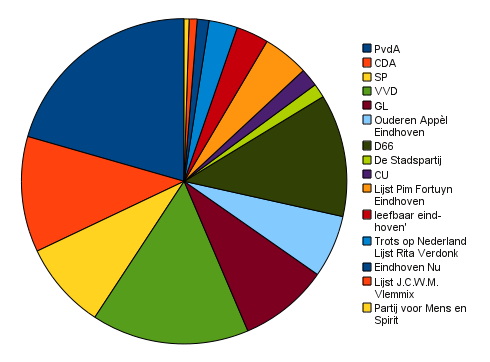 |
| CDA | 14,60% | 7 | 11,50% | 6 | |
| SP | 12,87% | 6 | 8,70% | 4 | |
| VVD | 11,78% | 6 | 15,65% | 8 | |
| GroenLinks | 7,07% | 3 | 8,88% | 4 | |
| leefbaar eindhoven | 8,88 % | 4 | 3,22% | 1 | |
| OuderenAppel Eindhoven | 4,88% | 2 | 6,23% | 3 | |
| D'66 | 3,33% | 1 | 12,19% | 6 | |
| Stadspartij | 2,44% | 1 | 1,40% | 0 | |
| Lijst Pim Fortuyn | 2,27% | 1 | 4,57% | 2 | |
| ChristenUnie | 2,22% | 1 | 1,81% | 0 | |
| Eindhovense Lijst Studenten | 1,69% | 0 | - | - | |
| Partij van de Toekomst (PvdT) | 1,05% | 0 | - | - | |
| Nieuw Rechts | 0,98% | 0 | - | - | |
| LIBERAAL EINDHOVEN | 0,90% | 0 | - | - | |
| Trots op Nederland/Lijst Rita Verdonk | - | - | 2,84% | 1 | |
| Eindhoven Nu | - | - | 1,16% | 0 | |
| Lijst J.C.W.M. Vlemmix | - | - | 0,80% | 0 | |
| Partij voor Mens en Spirit | - | - | 0,49% | 0 |
Council of Aldermen
The executive council in Dutch municipalities is called the College of the Mayor and Aldermen (Dutch: College van Burgemeester en Wethouders or College van B&W for short). The mayor is appointed by the monarch, but the council of aldermen is composed as a result of the formation of a local coalition government. This coalition is formed in such a way as to be able to rely on a majority of the votes in the city council.
In March 2010, a coalition was formed between PvdA, VVD, D'66 and GroenLinks. Together they have 28 seats in the city council. The council of aldermen consists of the following people[15]:
- Mary Fiers (PvdA)
- Housing
- Urban renewal
- Citizen's participation and government through city sections
- Spatial planning
- Urban development (e.g. the Meerhoven, Strijp S and Station area projects)
- Permit issuing
- Henk Brink (VVD)
- Economic affairs
- Brainport / SMB / Market affairs
- Higher and adult education
- Citymarketing
- Labor affairs
- Social affairs, re-integration and social employment
- External ICT
- BOR
- Students' city
- Mary-Ann Schreurs (D'66)
- Culture
- Design
- Innovation
- Real estate and ground management
- Public space (water, green, light, including maintenance)
- Cultural heritage, monuments and archeology
- Lenie Scholten (GroenLinks)
- Quality of life / WMO
- Poverty policy
- Healthcare
- Youth policy
- Primary education / preschool education / SPIL (all toddler-related activities) / secondary education
- Diversity policy / integration (of foreigners)
- Animal affairs
- Staf Depla (PvdA)
- Treasury
- Organization and Personnel
- Citizen services
- Operations management / ICT
- Reduction of Rules / the "Goed Geregeld" program
- Purchasing
- Joost Helms (VVD)
- Mobility, traffic and transportation
- Eindhoven Airport
- Sustainability and environment
- Waste management policy
- Tourism and events
- Coordination of BrabantStad and GSB
- Sport and recreation
Mayor
The mayors of The Netherlands are not elected but appointed by the crown. Nevertheless there has been a movement over the last few years to give the municipalities more say in who will be their mayor, which has resulted in consultative referenda being held in the larger cities to "suggest" a candidate for the post. This was also tried in Eindhoven and as a result the current mayor is Rob van Gijzel (PvdA).
On January 23, 2008, a referendum to elect a mayor was held in Eindhoven. This referendum, the second of its kind in the Netherlands, was attended by 24,6% of the inhabitants. This was less than the required 30% needed to make a referendum binding. Nevertheless, the city council would choose the winner of the referendum as the preferred candidate. The main reason for the low attendance was that the candidates, Leen Verbeek and Rob van Gijzel, were from the same party. Rob van Gijzel won the referendum with 61,8% of the votes and was appointed the city's new mayor.
The mayor is the chairman of the Council of B&W. He also has responsibility for a number of specific posts (like the aldermen). In the current council, mayor Van Gijzel holds responsibility for the following posts[15]:
- Integral safety and upholding of the law
- Legal affairs
- Communication
- External relations
- Civic affairs
If unavailable, the mayor is temporarily replaced by one of the aldermen. The current order of succession is:
- Mary Fiers
- Henk Brink
- Mary-Ann Schreurs
- Lenie Scholten
- Staf Depla
- Joost Helms
Culture and recreation
Culturally and recreationally, Eindhoven was formed by two forces:
- Being a university city, Eindhoven has a large student population. The students from the Eindhoven University of Technology and a number of undergraduate schools give Eindhoven a young population, whose recreational needs are catered to by several different festivals, clubs and such.
- Eindhoven was long the main location of Philips. The Philips company undertook a lot of effort in the "cultural formation" of its workforce and has given the city both cultural institutions (such as the former POC and the Muziekcentrum Frits Philips) and sporting institutions (notably PSV).
Eindhoven is also known as the City of Light, due to the Company Philips originating there and because of the several projects involving lighting up buildings of the city. During Carnival, Eindhoven is rechristened Lampegat (Hamlet of Lamps, although for the ironic purposes of carnival the translation Hole in the ground with lamps is closer to the mark); this refers again to the important role of Philips in the Eindhoven community.
Cultural institutions
There are several cultural institutions in and around the city.
Musea
- The Van Abbemuseum has a collection of modern and contemporary art, including works by Picasso, Kandinsky, Mondriaan and Chagall.
- The Museum Kempenland is a regional museum, which documents the history of the Kempenland region in objects, documents, paint and educational activities.
- The Historisch Openluchtmuseum Eindhoven is an open air, archeological museum which focuses on the region's Iron Age and Middle Ages.
- There are two musea dedicated to the major topics of the city's industrial heritage: the DAF Museum has a collection of DAF cars and the Philips Gloeilampenfabriekje anno 1891 (across the street from the Kempenland) documents the early lightbulb industry.
- The Centrum Kunstlicht in de Kunst (next door to the lightbulb museum) takes a more general look at lighting as an art form.
- The former district court house now houses the Designhuis, a public podium and interaction area for modern design and innovation.
- Finally, the Inkijkmuseum (the Look-In museum; housed in an old linen factory in the Dommelstraat) is a small but special museum: it offers ever-changing exhibits, which are to be viewed through the building's windows.
Eindhoven was home to the Evoluon science museum, sponsored by Philips. The Evoluon building is currently used as a conference centre.
Open air art
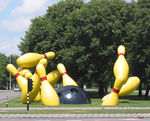
The Eindhoven public space contains many forms of artistic expression (a book published by the Eindhoven tourist board records 550 as of 2001 and more have been added since), with high "concentrations" of them in the parks. The Stadswandelpark for instance, contains over 30 works of modern art. There are also several other works of art on permanent display throughout the city, such as Flying Pins (by Claes Oldenburg and Coosje van Bruggen, who considered the location on the southern stretch of the John F. Kennedylaan to be like a bowling alley) and Swing (a construct on the Karel de Grotelaan, which morphs into different geometric shapes as you move around it). There are also a number of statues of famous city inhabitants, such as Jan van Hooff (by Auke Hettema, 1992) and Frits Philips (by Kees Verkade) on the Market Square. There is a statue of Anton Philips in front of the central railway station.
Eindhoven is also, to some degree, open to forms of impromptu and alternative art. For example, the Berenkuil is a freezone for graffiti artists in the city.
Music and theatre

The Effenaar is a popular music venue and cultural center in Eindhoven, it's located at the Dommelstraat.[16]
In 1992 the Muziekcentrum Frits Philips was opened as a stage for classical and popular music in Eindhoven, reviewed by critics as a concert hall with acoustics that rival the best halls in Europe. Before that, Philips sponsored the POC.
Parktheater Eindhoven is Eindhoven's stage for opera, cabaret, ballet etc. Opened in 1964, it has received over 250,000 visitors every year. With its 1000 m2 it has one of the largest stages in the Netherlands. With a major renovation ending in 2007, the new Parktheater will receive an estimated 300,000 visitors a year.
Eindhoven's Plaza Futura is now a cinema featuring cultural movies, lectures and special cultural events.
Especially for students, Studium Generale Eindhoven organizes "socially, culturally and intellectually formative events"[17]. From within the student body, two Tunas provide entertainment from time to time at university and city events: Tuna Ciudad de Luz (Tuna of the City of Light) and the ladies tuna La Tuniña[18][19].
The general music and theatre scene in EIndhoven (in the broadest sense) is supported by a foundation called PopEi[20]. The purpose of this foundation is to support artistic groups with facilities, especially rehearsal stages and areas (housed in the old Philips location of Strijp-S) but also storage facilities. PopEi also provides a working environment for groups (through cafeteria facilities in Strijp-S, so groups can have real working days) and provides some logistical support for organizing events.
Recreation
Eindhoven has a lively recreational scene. For going out, there are numerous bars on the Market square, Stratumseind (Stratum's End), Dommelstraat, Wilhelmina square and throughout the rest of the city. In addition to the more culturally oriented Plaza Futura, there are two cinemas in the centre of town ("Servicebioscoop Zien" and the Pathé Eindhoven, which offers THX sound, IMAX screens and 3D movie viewing). And there is a popular nightclub called De Danssalon on the Stationsplein.
Eindhoven also hosts a large number of cultural and entertainment-oriented festivals. The biggest festivals in Eindhoven are:
- ABlive, popfestival (September)[21]
- Carnaval, (February)
- Koninginnedag, national day (30 April)
- EDIT, festival (June)
- Fiesta del Sol, street- and music acts (June)
- UCI ProTour – Eindhoven Team Time Trial, international cycling tour (June)
- Virus Festival, alternative music festival (last edition in 2007, inactive at the moment)[22]
- Park Hilaria, fun fair (August)
- Folkwoods, folk festival (August)
- Reggae Sundance, reggae festival (August)
- Lichtjesroute, 15-mile-tour of light ornaments, commemorating the liberation of Eindhoven (from 18 September)
- Marathon Eindhoven, (October)
- Dutch Design Week, international school festival (October)
- Glow: Forum of Art and Light in Architecture, (November)[23]
- TROMP international music competition & Festival, international classical music competition & festival (15–23 November 2008: String Quartet, Nov 2010: Percussion)
- STRP Festival, art & technology festival (23–25 Nov 2007)[24]
The hip hop duo D.a.m.n., founder of Dutch hip hop, is based out of Eindhoven.
Parks
Eindhoven contains several parks and a lot of open, green space. Of the five large cities in The Netherlands it has the highest percentage of green area (encompassing about a third of all public space). It is also the greenest of the five largest cities in Noord-Brabant. The green area per house is about 100 m²[25].
Some of the major parks in Eindhoven are the Stadswandelpark, Genneper Parken, the Philips van Lenneppark, Philips de Jongh Wandelpark and the Henri Dunantpark. There is also a green area surrounding the Karpendonkse Plas (a water area). The combination of park area, water and general atmosphere got the Ooievaarsnest neighborhood elected the "Best large-city neighborhood of The Netherlands" by the NRC Handelsblad in 1997[26].
Sport

- PSV Eindhoven is the major football (soccer) club in the city. Playing in the Philips Stadion it is one of the dominant clubs in The Netherlands' top-ranked league, the Eredivisie. PSV won the national title a total of 21 times. Recent successes include the 2000, 2001, 2003, 2005, 2006, 2007 and 2008 national titles, finishing second in the league in 2002 and 2004. In international football, PSV were the 1988 winners of the European Cup (Champions League), the highest achievement in European club football.
- The second professional club is FC Eindhoven, which competes in the second league (Eerste Divisie).
- In field hockey the city has three major clubs, Oranje Zwart, Eindhovense Mixed Hockey Club (E.M.H.C.) and HC Eindhoven with Oranje Zwart as the most prominent one.
- Since 1990 the city of Eindhoven is the host of the annual Eindhoven Marathon.
- Eindhoven is the place where three-time Olympic swimming champion Pieter van den Hoogenband trains on a daily basis. He does so in the renovated swimming complex De Tongelreep under the guidance of his long-time coach and friend Jacco Verhaeren. Swimming success has inspired the renovation of the Tongelreep pool, which now has training and sports research facilities supported by the Eindhoven University of Technology and several top sporting institutions. Also, the competition pool has been upgraded to be a European grade competitive pool.
- Eindhoven houses Europe's largest indoor skateboard park Area 51 (skatepark) and is home of a lively skateboard culture.
- Eindhoven has two boxing clubs, The Golden Gloves and Muscle Fit.
- Eindhoven hosted the 1999 World Table Tennis Championships.
- Eindhoven has a baseball club called PSV, which plays at the stadium which co-hosted the 2005 IBAF Baseball World Cup.
- Eindhoven hosted 29th LEN European Championships Swimming, Diving and Synchronised Swimming championship in March, 2008
- Eindhoven has an Australian Rules Football team, the Eindhoven Eagles, due to play in the inaugural Dutch Australian Football Association competition in 2010.
Adult-oriented entertainment
Of course, not all of the entertainment in Eindhoven is family entertainment.
The centre of town features two casino's (one branch of Holland Casino and the independent Casino4Events). There is a night club called Club Massa and another called After Dark (which is really a strip club). Club Pecheur is a gay club.
Like every sizeable city in The Netherlands, Eindhoven also has its own sex industry. There is a red light district on the Baekelandplein, as well as some four brothels throughout the city. There is also a blue movie theater (featuring heterosexual movies).
Transport
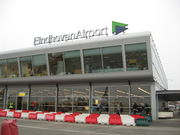
Eindhoven Airport serves as a military air base and a civilian commercial airport.
Eindhoven is a rail transport hub. The main station has connections in the directions of:
- Tilburg – Breda – Dordrecht – Rotterdam – Delft – The Hague[27]
- 's-Hertogenbosch – Utrecht – Amsterdam – Alkmaar[28]
- 's-Hertogenbosch – Utrecht – Amsterdam Zuid – Schiphol Airport[28]
- Helmond – Venlo[29]
- Weert – Roermond – Sittard – Maastricht/Heerlen[30]
Eindhoven's central railway station is served by both intercity and local services while the smaller station, Eindhoven Beukenlaan is only served by local trains.
Up until World War II, a train service connected Amsterdam to Liège via Eindhoven and Valkenswaard, but the service was discontinued and the line broken up. Recently, talks have resumed to have a service to Neerpelt, Belgium via Weert.
Located approximately 8 kilometres from the town centre, Eindhoven Airport is the closest airport nearby, and the second busiest in the country (after Schiphol). There are flights with Air France to London City, and Ryanair serves London Stansted airport, Dublin, Rome, Milan, Pisa, Marseille, Glasgow, Madrid, Valencia, Stockholm and Barcelona. In the summerseason, Reykjavík is served with 2 weekly flights operated by Iceland Express.
The A2 / E25 motorway from Amsterdam to Luxemburg passes Eindhoven to the west and south of the city. The A2 connects to the highway A58 to Tilburg and Breda just north of the city. Just south of Eindhoven, the A2 connects to the A67 / E34 between Antwerp and Duisburg. In 2006, the A50 was completed connecting Eindhoven to Nijmegen and Zwolle.
The public transport of Eindhoven consists of almost 25 city bus lines, which also serve neighbouring cities like Veldhoven, Geldrop and Nuenen. Two of these buslines (401 and 402) are high quality public transport and the buses on these lines are so-called Phileas vehicles, a combination of tram and bus. The Phileas does not use the magnetic guidance anymore for some years due to the regional urban transport authority (SRE). Apart from the city lines there are some 30 regional and rush-hour lines.
Medical care
Eindhoven has two hospitals in three locations: the Catharina Hospital and the Máxima Medisch Centrum, which has a branch in Eindhoven Centrum (the old Diaconessenziekenhuis) and one in Veldhoven (the old Sint Joseph Hospital). These three have an extensive cooperation and have divided specialties among each other. Emergency medicine, for example, is concentrated in the MMC Veldhoven branch, whereas cardiac procedures are done in the Catharina.
Catharina is also an academic and research hospital and participates in a shared research program with Philips Medical, the Eindhoven University of Technology and the Maastricht University into biomedical science, technology and engineering.
Notable residents

- Kees Bol (since 1916), painter and art educator
- Jan de Bont (1943), film director
- Arthur Borren (1949), (field) hockey player
- Jan Borren (1947), (field) hockey player and coach
- Jan van Hooff (1755–1816), statesman
- Lenny Kuhr (1950), singer/songwriter
- Piet Souer (1945), Record producer
- Gerard Philips (1858–1942) and Anton Philips (1874–1951), founders of the Philips brand name.
- Frits Philips (1905–2005), businessman, son of Anton Philips
- Hugo Brandt Corstius (1935), writer
- Peter Koelewijn (1940), musician and record producer
- Tineke Bartels (1951), equestrian
- François van Kruijsdijk (1952), medley swimmer
- Robert de Wit (1962), decathlete and bobsledder
- Bas Rutten (1965), MMA sportsman, color commentator, actor
- Rik Smits (1966), basketball player
- Paul Haarhuis (1966), Tennis player
- Theo Maassen (1966), comedian and actor
- Patrick Lodewijks (1967), football goalkeeper
- Phillip Cocu (1970), football player
- Margje Teeuwen (1974), (field) hockey midfielder
- Imke Bartels (1977), equestrian
- Christijan Albers (1979), racing driver
- Sander van Doorn (1979), Techno/Trance music DJ and producer
- Lonneke Engel (1981), fashion model
- Rob Reckers (1981), (field) hockey player
- Cor Vriend (1949), long-distance runner, on the time manager for long-distance runner
- Klaas-Erik Zwering (1981), swimmer
- Wieger van Wageningen (1983), professional skateboarder
- Rick VandenHurk (1985), professional baseball player
- Remmert Wielinga (1978), professional road bicycle racer
International relations
Twin towns – sister cities
Eindhoven is twinned with:
|
See also
- Eindhoven University of Technology
- PSV Eindhoven
- FC Eindhoven
- Eindhoven Airport
- Jewish Eindhoven
References
Notes
- ↑ (Dutch) Groei van Eindhoven
- ↑ 2.0 2.1 Eindhoven Population Central Bureau of Statistics. Accessed 29 August 2010 (Dutch)
- ↑ eindhoven.buurtmonitor.nl bij "bevolking->stand bevolking"
- ↑ (Dutch) [1]
- ↑ (Dutch) "Gereg.criminaliteit; misdrijven naar soort misdrijf en politieregio". CBS Statline. 07 July, 2010. http://statline.cbs.nl/StatWeb/publication/?DM=SLNL&PA=80344NED&D1=0&D2=0-1,62,87,104-105,114,117,121-122&D3=22&D4=l&HDR=T,G3&STB=G1,G2&VW=T. Retrieved 2 September 2010.
- ↑ "Centrum kunstlicht in de kunst te Eindhoven. Museum voor lichtkunst en lichteffecten" (in (Dutch)). Kunstlichtkunst.nl. http://www.kunstlichtkunst.nl. Retrieved 2009-05-05.
- ↑ "Philips gloeilampenfabriekje anno 1891". Philipsfabriek1891.nl. http://www.philipsfabriek1891.nl. Retrieved 2009-05-05.
- ↑ (Dutch)Brainport Top Technology Region website
- ↑ Brainport Development website
- ↑ (Dutch)SRE website
- ↑ ELAt.org The ELAt website
- ↑ http://eit.europa.eu/home.html
- ↑ http://eit.europa.eu/fileadmin/Content/Downloads/PDF/news_items/Summary_InnoEnergy.pdf
- ↑ (Dutch) The Dutch database of election results, including all election results since 1848
- ↑ 15.0 15.1 (Dutch) "Burgemeester en wethouders 2010 - 2014". Gemeente Eindhoven. http://www.eindhoven.nl/gemeente/college-van-BW/Burgemeester-en-wethouders-2010-2014.htm. Retrieved 1 September 2010.
- ↑ Evenement. "Effenaar". Effenaar.nl. http://www.effenaar.nl. Retrieved 2009-05-05.
- ↑ (Dutch) Studium Generale (English page available on site)
- ↑ "Tuna Ciudad de Luz". Tuna Ciudad de Luz. http://w3.tunacl.nl/index.php?id=en. Retrieved 29 August 2010.
- ↑ "La Tuniña". La Tuniña. http://www.stud.tue.nl/~tunina/index%20Engels.html. Retrieved 29 August 2010.
- ↑ (Dutch) PopEi official website
- ↑ "ABlive gratis festival Eindhoven 23 Augustus 2008". Ablive.nl. http://www.ablive.nl. Retrieved 2009-05-05.
- ↑ "Stichting Virus – Startpagina". Virus.nl. http://www.virus.nl. Retrieved 2009-05-05.
- ↑ "Glow Eindhoven". Glow Eindhoven. http://www.gloweindhoven.nl. Retrieved 2009-12-02.
- ↑ "STRP Festival". Strp.nl. http://www.strp.nl. Retrieved 2009-05-05.
- ↑ Eindhoven de Gruunste!, eindhoven.nl
- ↑ (Dutch) "Profiel: Buurten in Nederland". NRC Handelsblad. 18 September 1997. http://retro.nrc.nl/W2/Lab/Profiel/Buurten/stad.html. Retrieved 02 September, 2010.
- ↑ "Weert, Sittard, Heerlen/Maastricht". Archived from the original on 2008-02-27. http://web.archive.org/web/20080227025738/http://www.ns.nl/www.ns.nl/pdf/vertrekstaten/ehv4.pdf.
- ↑ 28.0 28.1 "'s-Hertogenbosch, Utrecht Schiphol/Amsterdam, Alkmaar". Archived from the original on 2008-02-27. http://web.archive.org/web/20080227025742/http://www.ns.nl/www.ns.nl/pdf/vertrekstaten/ehv2.pdf.
- ↑ "Helmond, Venlo / Eindhoven Beukenlaan / Best en Boxtel". Archived from the original on 2008-02-27. http://web.archive.org/web/20080227025746/http://www.ns.nl/www.ns.nl/pdf/vertrekstaten/ehv1.pdf.
- ↑ "Weert, Sittard, Heerlen/Maastricht". Archived from the original on 2008-02-27. http://web.archive.org/web/20080227025749/http://www.ns.nl/www.ns.nl/pdf/vertrekstaten/ehv3.pdf.
- ↑ "Twin towns of Minsk". Minsk City Executive Committee. http://minsk.gov.by/cgi-bin/org_ps.pl?k_org=3604&mode=doc&doc=3604_2_a&lang=eng. Retrieved 2008-12-08.
External links
Other
- The official international site of the city of Eindhoven
- The city of Eindhoven on the Internet
- InternetGemeentegids Eindhoven over 1450 links
- Website of the local rockscene, Eindhoven Rockcity
- Eindhoven-in-Beeld
- Regional Historical Centre RHC-eindhoven
- Eindhoven's history in 8 maps and 1 section – Urbanism and city development
- The Van Abbe Museum of Modern Art
- Eindhoven University of Technology
- Eindhoven-eertijds.tk
- The City Stage-Park Theater
- The Concert Hall
- International Education in Eindhoven
Images
- A photo history of Eindhoven
- Eindhoven early 20th century photography – Photos of streets and buildings from a while ago
- Eindhoven in Site: Photos, Virtual city tour.
- Eindhoven in Beeld, picture and movie archive of Eindhoven
Maps
- City centre map
- A map of the Eindhoven city centre, showing a number of important landmarks in the city. Among these are the City Office (marked by the coat of arms) and the nearby City Hall, the Museum Kempenland and the Van Abbemuseum, St. Catharine's Church (church image), the Philips Football Stadium, the Piazza and the Witte Dame. The Admirant and Philips Lighting Museum are marked in green, the Music Centre Frits Philips in blue. Purple marks the entrances to the Heuvel Galerie shopping mall and orange indicates the entrances to the railway station and the central bus terminal.
- City overview map
- An overview map of the entire city. This map shows the different parts of the city (Gestel, Stratum, Strijp, Tongelre, Woensel), as well as the airport and major parks. Photo insets indicate the locations of the University of Technology and the Evoluon Conference Centre. The green marker shows the location of the Eindhoven High Tech Campus. The blue marks indicates the Tongelreep National Swimming Centre.
|
|||||||||||


